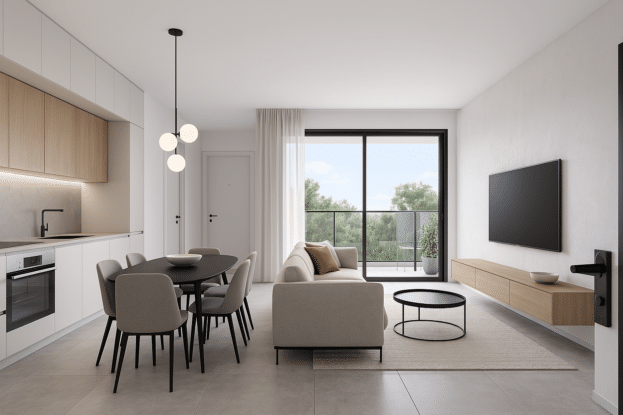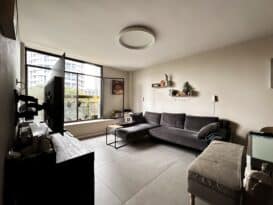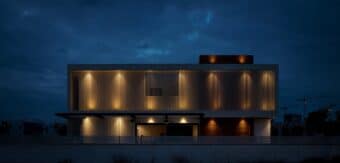Once considered shorthand for a bare-bones kitchen and the cheapest tiles and faucets around, the ‘contractor apartment’ has undergone a transformation. In the competitive race for every buyer, new apartment finishes now feature high-end German and Italian brands in place of budget kitchens and sanitary fixtures, doors and handles are now designer-crafted, and an EV charging station may be waiting in the parking lot. As one developer puts it: “If a buyer wants to upgrade today, we have to ask why.“
By Hadas Magen, Nadlan Center
Contractor apartments are generally synonymous with minimal specs. They have everything you need—but at a basic level: inexpensive tiles, a minimal kitchen, and the simplest quality and design for sanitary fittings. Anyone who wants more—can upgrade at their own expense.
But over the past two years, during which selling apartments has become more challenging due to rising interest rates and a slowdown, contractors have realized that the spec offered is a key tool in the fight for buyers’ hearts and wallets. Accordingly, the standard of contractor apartment specs has significantly increased, far beyond the minimum. Elements that were once upgrades paid for by buyers are now provided as standard: large tiles, sophisticated air conditioning systems, wall-hung toilets, electric blinds, and smart systems. Even an electric car charging station in the parking lot is sometimes now included in the price.
“In the past, ‘contractor apartments’ was a dirty word, but today it’s something you can live with very well,” says Roni Cohen, CEO of Eldar Real Estate Marketing. “Twenty years ago, for example, not all companies provided air conditioning in apartments. Today, not only is a central mini-split system standard, but in many cases, a VRF system (which allows cooling only certain rooms and thus saves electricity) is included. This continues with tile sizes, which are now much larger, and can be seen not just in luxury projects but also in standard ones.”
Cohen continues about blinds: “If once contractors didn’t provide electric blinds at all, and then only in the living room, today the standard is electric blinds throughout the house. Same with balconies: not only does every apartment have one today, but it actually serves for entertaining—far from the ‘smoking balcony’ we used to get. Regarding safe rooms—they used to be provided only with an inconvenient steel door. Today, in many cases, the contractor also provides a wooden door in addition.”
And if that’s not enough, Cohen describes other new apartment finishes once considered true luxuries: “Smart electrical systems, for example, can now be found in contractor apartments. In the bathrooms, wall-hung toilets—which were once considered luxury—are now standard, and in some projects shower enclosures are also included. There has also been progress in kitchens, with most projects now offering very decent kitchens.”
Cohen notes that in recent years, green building segments have also entered contractor apartments, “though not enough,” he says. “Some projects provide ceiling fans, water-saving faucet inserts, high-level insulation, and underground pneumatic garbage disposal. You can see these not only in luxury projects but also in neighborhoods like Green Kfar Saba or Green Yavne.”
Luxury brands in kitchens and bathrooms
According to Dror Ohev Zion, owner and CEO of Dera Real Estate Marketing, specs are constantly rising: “If flower-shaped faucets used to be the standard, today the standard is wall-mounted faucets. A central mini-split is the bare minimum, and in kitchens, you can find contractor apartments with Semo kitchens and German kitchens, and in some cases, like apartments in Tel Aviv and Jerusalem, even Bulthaup kitchens. The brands are also found in bathrooms, like Grohe sanitary ware, and in some cases, contractors provide smart home systems.”
If you go down to the building lobbies, the higher the better, and ceiling height has also risen in the apartments themselves, sometimes, according to Ohev Zion, reaching up to 4 or even 4.5 meters. Doors have also improved, and in some projects, Zero Line doors (flush with the wall, without visible frames) in color and with soft-close mechanisms are now standard.
Maya Donerstein Yatir, VP of Marketing at Rav-Bariach: “We see a rise in door height. If, in the past, doors were a standard height of 2.05 meters, made of Formica with regular handles, today, the demand is for higher openings of up to 2.20 meters, creating a luxurious and impressive look. In addition, contractors are choosing to invest in interior doors from luxury collections in various designs, including Zero Line doors, and if the project includes a renowned architect, they design individual styles for the project.”
According to Maya Donerstein Yatir, VP of Marketing at Rav-Bariach Group, which provides designer entry and interior doors and locking products, the standard in real estate projects regarding doors has significantly risen—both in design and quality. “In nearly all mid-range and up projects, smart entry doors are now provided as part of the contractor’s spec. This is a designer door with a concealed smart lock, enabling smart opening and locking via app, fingerprint, or keypad.” Regarding interior doors, she says, most contractors now provide painted-finish doors with upgraded handles as standard.
All this applies to the standard apartment market. In the luxury apartment market, says Donerstein Yatir, things have gone wild. “We’re seeing three main trends. One – rising door heights. If in the past, doors were 2.05 meters tall, Formica, with standard handles, today the demand is for higher openings up to 2.20 meters, for a luxurious, impressive appearance. In addition, contractors invest in luxury collections for interior doors in various designs, including Zero Line doors, and when there’s a notable architect, they create custom designs for the project, like specially designed doors for the Exchange project by Azorim.”
“Another trend is elegant handle designs. In luxury projects, instead of a simple standard handle, the handle is treated as ‘the door’s jewel’ with black Italian handles, gold-painted, brushed black, or gray. Lobby doors also occupy large surface areas, and contractors now understand they must be designed and impressive.”
“When a Tenant Upgrades – We Check Why”
Yonatan Ezer, VP of Urban Renewal at Y.D. Barzani admits that to attract potential buyers, “you have to offer high-level specs. For example, everything related to smart home and green building: if they once offered just prep for electric car charging, today they also provide the infrastructure. And if they once gave an electric boiler, now many projects provide prep for solar panels.”
Regarding windows, Ezer says that since many projects involve mixed-use buildings, contractors provide double-glazed windows. Electric blinds are now a basic element, and there are even “light blinds,” which keep the apartment bright even when closed. As for apartment layout, planning now includes space for a work corner, and in any case, the company provides buyers with 8–10 hours of interior design consultation to tailor the apartment to their needs.
Dror Ohev Zion, owner and CEO of Dera Real Estate Marketing, says specs are constantly rising: “If flower faucets used to be standard, today it’s wall-mounted faucets. A central mini-split is the bare minimum, and in contractor apartments you can now find Semo kitchens, German kitchens, and in some cases, like in Tel Aviv and Jerusalem, even Bulthaup kitchens. The brands extend to bathrooms too, like Grohe sanitary fittings, and in some cases, contractors provide smart home systems.”
Eran Edri, development manager at Yuvalim Group, which is currently building the KAI-MA project near Tzomet Savion—a 700-unit urban renewal project in eight towers across approximately 17 dunams—says that for them, “if a buyer chooses from what we offered and doesn’t upgrade, that’s a success.” So much so that when a buyer upgrades, he says, “We check why.”
Edri explains that in this project, because it includes 700 apartments, the company has bargaining power with suppliers, allowing them to offer not just a variety of vendors and models, but also high-level specs. For example, “in terms of air conditioning, we were able to upgrade the system by an entire generation and provide the most advanced AC with minimal electricity consumption.”
The project’s scale also allowed them to supply high-quality sanitary fittings—toilets, coverings, faucets, and cabinets. “The more we invest in the new apartment finishes,” he says, “the less desire there is to upgrade.” He adds that in Tel Aviv, it’s necessary to provide a higher standard in apartments compared to other locations because ultimately, “when someone buys an apartment for NIS 95–100,000 per square meter, they want the best.”







